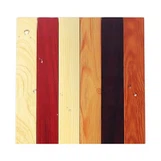Alloy honeycomb sheets have gained significant popularity in various industries due to their unique combination of strength, lightweight properties, and aesthetic appeal. As a leading supplier of alloy honeycomb sheets, I often receive inquiries from customers about the lifespan of these products. In this blog post, I will delve into the factors that influence the longevity of alloy honeycomb sheets and provide insights into how long you can expect them to last.
Understanding Alloy Honeycomb Sheets
Before discussing the lifespan of alloy honeycomb sheets, it's essential to understand what they are and how they are constructed. Alloy honeycomb sheets are composite materials made up of two outer layers (skins) bonded to a honeycomb core. The skins are typically made of materials such as aluminum, stainless steel, or fiberglass, while the core is a hexagonal honeycomb structure made of aluminum or other lightweight alloys.


This unique construction gives alloy honeycomb sheets several advantages, including high strength-to-weight ratio, excellent stiffness, and good energy absorption properties. They are commonly used in applications such as aerospace, automotive, marine, and architecture, where weight reduction and structural integrity are crucial.
Factors Affecting the Lifespan of Alloy Honeycomb Sheets
The lifespan of alloy honeycomb sheets can vary depending on several factors, including:
- Material Quality: The quality of the materials used in the construction of the alloy honeycomb sheet plays a significant role in its lifespan. High-quality materials are more resistant to corrosion, wear, and fatigue, which can extend the product's lifespan.
- Environmental Conditions: The environment in which the alloy honeycomb sheet is used can also affect its lifespan. Exposure to harsh weather conditions, such as extreme temperatures, humidity, and saltwater, can accelerate the corrosion process and reduce the product's lifespan.
- Installation and Maintenance: Proper installation and maintenance are essential for ensuring the longevity of alloy honeycomb sheets. Incorrect installation can lead to stress concentrations and premature failure, while regular maintenance can help detect and address any issues before they become major problems.
- Load and Usage: The load and usage conditions of the alloy honeycomb sheet can also impact its lifespan. Excessive loads or frequent use can cause fatigue and wear, which can shorten the product's lifespan.
Average Lifespan of Alloy Honeycomb Sheets
Based on industry experience and research, the average lifespan of alloy honeycomb sheets can range from 10 to 30 years. However, this can vary significantly depending on the factors mentioned above. In ideal conditions, with high-quality materials, proper installation, and regular maintenance, alloy honeycomb sheets can last even longer.
For example, in aerospace applications, where alloy honeycomb sheets are subjected to extreme conditions and strict safety requirements, they are designed to have a lifespan of at least 20 years. In architectural applications, where the sheets are used for cladding and interior design, they can last for 15 to 30 years, depending on the environmental conditions and maintenance practices.
Extending the Lifespan of Alloy Honeycomb Sheets
While the lifespan of alloy honeycomb sheets is influenced by several factors, there are several steps you can take to extend their lifespan:
- Choose High-Quality Materials: When selecting alloy honeycomb sheets, choose products made from high-quality materials that are resistant to corrosion, wear, and fatigue. Look for products that meet industry standards and have a proven track record of performance.
- Proper Installation: Ensure that the alloy honeycomb sheets are installed by a qualified professional who follows the manufacturer's installation instructions. Proper installation can help prevent stress concentrations and ensure the structural integrity of the product.
- Regular Maintenance: Regular maintenance is essential for ensuring the longevity of alloy honeycomb sheets. Inspect the sheets regularly for signs of damage, corrosion, or wear, and address any issues promptly. Clean the sheets periodically to remove dirt, debris, and other contaminants that can accelerate the corrosion process.
- Protect from Harsh Environments: If the alloy honeycomb sheets are exposed to harsh environmental conditions, such as extreme temperatures, humidity, or saltwater, take steps to protect them. Apply a protective coating or finish to the sheets to prevent corrosion and damage.
Conclusion
In conclusion, the lifespan of alloy honeycomb sheets can vary depending on several factors, including material quality, environmental conditions, installation, and maintenance. On average, alloy honeycomb sheets can last from 10 to 30 years, but with proper care and maintenance, they can last even longer.
As a supplier of alloy honeycomb sheets, we are committed to providing our customers with high-quality products that meet their specific needs and requirements. Our Environmental Frinedly Aluminum Honeycomb Panel, Wood Honeycomb Panels, and Honeycomb Aluminium Sheet 1.5x2.0meters are made from high-quality materials and are designed to provide long-lasting performance.
If you are interested in learning more about our alloy honeycomb sheets or have any questions about their lifespan, please contact us. Our team of experts will be happy to assist you and provide you with the information you need to make an informed decision.
References
- ASM Handbook, Volume 1: Properties and Selection: Irons, Steels, and High-Performance Alloys. ASM International, 1990.
- Aluminum Association. Aluminum Design Manual. Aluminum Association, 2015.
- ISO 9001:2015. Quality management systems - Requirements. International Organization for Standardization, 2015.




